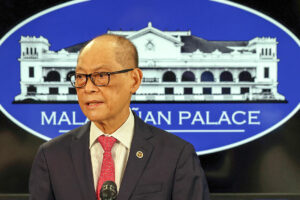




Philippines Trade Update: Trade trajectories trend along
 DOWNLOAD
DOWNLOAD

Policy Rate Updates: Double cut finale
 DOWNLOAD
DOWNLOAD

Monthly Economic Update: One for the road
 DOWNLOAD
DOWNLOAD


BSP may pause tightening — Diokno

THE BANGKO SENTRAL ng Pilipinas (BSP) may consider a smaller 25-basis-point (bp) rate hike or even pause monetary policy tightening at its meeting on Thursday amid heightened global uncertainties, Finance Secretary Benjamin E. Diokno said on Monday.
Mr. Diokno, a member of the Monetary Board (MB), said the recent global developments may prompt central banks all over the world to slow the pace of rate hikes.
“There’s very little contagion on the Philippine side. Central banks are likely to ease on the hiking of interest rates, and so that’s the positive side of this,” he said at a forum organized by the Foreign Correspondents Association of the Philippines.
Global markets have been rattled by turmoil in the banking sector, which began with the collapse of Silicon Valley Bank (SVB) and Signature Bank in the United States. Troubled Swiss bank Credit Suisse needed a state-backed rescue by its rival UBS Group, as regulators sought to calm markets.
“The Philippines won’t be affected directly, because we do not have any transactions with the Silicon Valley Bank or even Credit Suisse, etc.,” Mr. Diokno said.
The US Federal Reserve will start its two-day meeting on Tuesday, while the BSP’s Monetary Board is scheduled to hold its meeting on March 23.
Mr. Diokno said the only options are to hike by 25 bps or to keep rates unchanged on Thursday.
“Maybe before we talked about 25 bps, and even a likelihood of a hold or steady. We will hold it for a while knowing there are many uncertainties. That will depend on the MB board,” Mr. Diokno said.
The Monetary Board raised its benchmark interest rate by 50 bps for a second straight meeting in February, bringing the key rate to a near 16-year high of 6%. Since May, the central bank hiked rates by a total of 400 bps.
A BusinessWorld poll last week showed 12 out of 14 analysts expect the Monetary Board to hike rates by 25 bps at its March 23 meeting.
In its Market Call report on Monday, First Metro Investment Corp. (FMIC) and the University of Asia and the Pacific (UA&P) said they expect the BSP to raise its rates by 25 bps at its next two meetings amid expectations of easing inflation.
“There is an upside risk if the Fed hikes its policy rates by 50 bps in the March 21-22 meeting. BSP will likely not want to extinguish the economic recovery momentum,” FMIC and UA&P said.
At the same time, Mr. Diokno said he is “optimistic” that inflation could ease to 4% by the end of the third quarter.
“The price of oil has been declining, the peso has been appreciating and we have put in place mechanisms to control the price of food items, which is a major trigger of inflation,” he added.
Inflation eased to 8.6% in February from a 14-year high of 8.7% in January.
BSP Governor Felipe M. Medalla earlier said inflation will ease to within the 2-4% target by November or December this year.
The BSP sees inflation averaging 6.1% this year, and easing to 3.1% in 2024.
Mr. Diokno also said there is a high probability the banks’ reserve requirement ratio (RRR) will be cut to a single-digit level by the end of the year.
The RRR for big banks is currently at 12%, one of the highest in the region. Reserve requirements for thrift and rural lenders are at 3% and 2%, respectively.
A cut in RRR is a move intended to be an operational adjustment to facilitate the BSP’s shift to market-based instruments for managing liquidity in the financial system, particularly the term deposit facility and the BSP securities.
Budget
Meanwhile, Mr. Diokno said the National Government is unlikely to have a balanced budget in the next decade.
“Given the state of our economy, I don’t see us having a balanced budget in the next 10 years. As long as revenues exceed current operating expenses, then we still have enough money for capital outlays and that’s fine,” he said.
The Philippines’ budget balance swung to a surplus of PHP 45.75 billion in January, a turnaround from the PHP 23.38-billion deficit a year earlier.
The last time the government recorded a budget surplus was in April 2022, with PHP 4.94 billion.
“It’s not appropriate to shoot for a surplus this time. We are investing 6% for infrastructure, we will continue to invest for infrastructure, because the Philippines has been left behind,” Mr. Diokno said.
This year, the government set a budget deficit ceiling of PHP 1.47 trillion, equivalent to 6.1% of GDP. — Luisa Maria Jacinta C. Jocson
This article originally appeared on bworldonline.com





 By BusinessWorld
By BusinessWorld